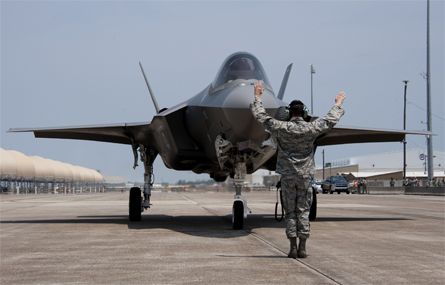Lockheed Martin will retrofit the first 64 production models of the F-35A and F-35B, after discovering a second aluminium part supplied by US-based producer Alcoa failed in durability tests.
The redesigned wing forward root rib forgings will be installed on new aircraft ordered by the US Air Force and US Marine Corps in the fifth yearly lot of low-rate initial production, according to the F-35 joint programme office (JPO).
The new structural problem was revealed even as the test fleet was cleared to resume un-monitored flying on 26 August, after Lockheed fixed a problem with the F-35's power system.
On 2 August, the Honeywell integrated power package failed, after a valve malfunctioned during a routine ground test on the AF-4 test aircraft.
 |
|---|
© Lockheed Martin |
All test aircraft were cleared to resume monitored flights on 18 August, with un-monitored tests cleared eight days later.
Early production aircraft remain effectively grounded, however, until a software modification can be installed in late September or October, the JPO said.
The production models have been cleared to complete one ferry flight from Fort Worth, Texas, to Eglin AFB, Florida, as they are delivered.
The structural problem is the second design change to be discovered in the 16,000h regimen of durability tests started last year.
The first problem was revealed when the Alcoa-supplied 496 bulkhead in the rear fuselage of the F-35B cracked unexpectedly only 10% through the durability test cycle.
Lockheed designed a patch to ensure the test fleet could survive long enough to complete the flight test programme.
According to the JPO, Lockheed's engineers were aware of the weakness problem in the root rib forgings as the aircraft entered durability tests.
The only surprise was that cracks appeared slightly later than expected, at 2,800h - about 17.5% through durability tests, the JPO said.
Alcoa is working with Lockheed Martin to address the issue. “It is not unusual to identify improvement opportunities during testing,” the company said. “At no time was flight safety compromised.”
Despite the 16-day flight test hiatus in August, the flight test programme has not fallen far behind schedule.
The F-35A variant for the USAF is 20 flights ahead of schedule, and the F-35C variant for the US Navy is lagging by five flights. Furthest behind schedule is the F-35B, which is 30 flights behind the scheduled pace.
Source: Flight International



















